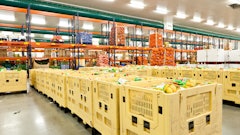
The City of New York is pumping $27 million into the Hunt's Point Food Distribution Center in the Bronx in an effort to spur growth of food-related businesses in the area. Those efforts are starting to pay off in a big way, as the facility has in the last few months attracted some very high-profile tenants.
Just last month, the Fulton Fish Market—the largest wholesale fish market in the United States—relocated to Hunts Point from the lower Manhattan space it had occupied for 180 years. Baldor Specialty Foods moved into a newer and larger 185,000-square-foot refrigerated warehouse there, and Anheuser-Busch plans to relocate a distribution center from the Long Island City section of Queens to a new 167,000-square-foot facility at Hunts Point.
It's all about location in the transportation business and Hunts Point is in a prime location. The Nearby Bruckner Expressway connects Hunts Point to the Ports of New York and New Jersey, and to I-95 and all the Northeast and Midwest markets. The Food Distribution Center employs about 11,000 people and encompasses 18 warehouses.
"The Bronx is the only one of five counties in New York City that is connected to mainland U.S., so it gives companies access to anywhere without going over a bridge," says Rafael Salaberrios, president of the Bronx Overall Economic Development Corp., which is responsible for running the federally designated Empowerment Zone in the Bronx.
Hunts Point houses the Terminal Produce Market, the Cooperative Meat Market and Fulton Fish Market, which just moved into a brand-new state-of-of-the-art 430,000 square-foot facility (see sidebar). The Fulton Fish Market is expected to bring in more than $1 billion annually in economic activity. The meat and produce markets themselves, encompassing more than 115 distinct businesses, generate more than $3 billion annually. The produce market provides more than 2.7 billion pounds of fresh fruits and vegetables annually and this market alone receives about 3,000 rail cars annually on the CSX Railroad.
Just a year ago, 50 tons of apples from Washington State arrived by rail at the regional distribution facility of The Great Atlantic & Pacific Tea Co., operating here for more than 30 years. This was the first shipment to the A&P DC since NYCEDC upgraded the rail-grade crossing serving the facility. A&P will receive two shipments of three to four cars every week. EDC says receiving just two trains a week reduces truck traffic in Hunts Point by more than 1,000 trips annually. EDC contracted with CSX Railroad to maintain the 400-foot railroad track crossing at the city-owned Hunts Point Distribution Center.
The rail infrastructure at Hunts Point is being upgraded to encourage more use of rail movement to curb air pollution and truck traffic on city streets. Direct access into Hunts Point from either the Bruckner or Sheridan expressways will expedite shipments. The city has secured more than $10 million in city, state and federal funds for transportation improvements throughout the industrial park.
Numerous business incentives are available to companies considering locating or expanding in the area. These include tax-exempt bond financing for manufacturers, property tax reductions, waivers from mortgage recording tax, exemptions from sales and use taxes on construction and equipment costs, and discounted energy rates.
The Hunts Point Terminal Produce Cooperative Market daily feeds 22 million people in a four-state area, including metropolitan New York City, New Jersey, southern Connecticut and northern Pennsylvania. "We also sell as far north as Canada, and south to Florida and west to Chicago, and some merchants even sell into Western Europe and the Caribbean Basin every day," says Myra Gordon, its executive administrative director.
The market is the largest wholesale produce market in the country and, from the perspective of the amount of dollars flowing through it, the largest in the world, generating about $2 billion just in the sale of fresh fruits and vegetables. About 4 billion pounds of produce flow through the market every year, with produce coming in from about 55 foreign countries and ust about every state in the Union.
"Everything that grows anywhere in the world finds its way into this market because we are the largest, and secondly, because there are 17,000 restaurants in the five boroughs," Gordon says. "One hundred percent of the produce used by these restaurants comes from this market either directly or indirectly. We are feeding a very sophisticated population because what people see in the restaurants they visit they want to be able to use at home. And our restaurateurs are always looking for something new and exciting. Produce I never even heard of or saw a few years ago has now become commonplace in this part of the country," she says.
Produce arrives at the market by a number of transportation modes, including boxcar, intermodal and truck. About 2 percent of incoming seafood and other highly perishable foods arrive by plane. Produce and products, such as bananas coming out of Chile, Argentina, Ecuador and Venezuela, arrive by ship through nearby ports. "Most of our produce arrives on semis from California and Arizona," says Gordon. Potatoes and onions arrive by rail from Montana and Idaho using the Southern Pacific and Northern Pacific railroads to Chicago, where shipments are then picked up by CSX for delivery right into the market. About nine miles of rail spurs feed into the market, facilitating deliveries to individual produce companies.
Merchants are shipping to foodservice companies, supermarket chains and upscale green grocers in the metro New York City area. "They also supply 2,500 Korean green grocers and numerous bodegas catering to the Latino population," Gordon says.
Hunts Point was chosen because of its accessibility to all the major highways in the region. "It's just a short ride to the George Washington Bridge and to I-95 north and south; or to the Major Deegan Expressway and the FDR Drive into Manhattan. So many regions can easily be served from this area," says Gordon.
The cooperative market manages the real estate and everyone is a member of the cooperative. Each merchant has a stall of 1,875 square feet, in addition to a 25-foot loading platform in front of the unit. There is a total of 1 million square feet under one roof at the market.
Currently, plans are being considered to re-build the market and construction will begin in about two years. "We will be re-building on the current site and we have enough room in back of the market to do this while keeping our merchants in business so their businesses are not disrupted," Gordon says. The reason for the expansion is to offer merchants more room to operate their businesses. "Our primary concern at this point is to provide our current merchants the opportunity to expand and then we will bring in incubator companies who would like to do business here but cannot because there is no space at the moment."
Gordon says being located in an Empire Zone allows merchants to save 4.25 percent on the state tax. "There are also employee credits available if you hire people who live in the Empire Zone," she says.

























